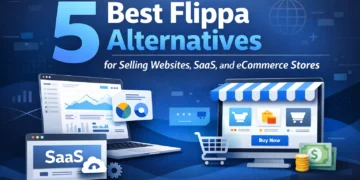If you’re thinking about selling your dropshipping website, you’re likely at a pivotal moment. You may have reached your goals and want to cash out, or perhaps you’re facing obstacles that make continuing more difficult. Selling your dropshipping business can be a smart move, especially if your store has built a solid customer base, reliable suppliers, and a proven track record of sales.
Dropshipping is an appealing business model due to its low overhead costs and the ability to operate entirely online. This makes it an attractive option for potential buyers. However, to ensure a smooth and profitable sale, it’s essential to understand the process from preparation to negotiation.
Whether your website is built on platforms like Shopify or custom e-commerce solutions, it represents a valuable asset. Highlighting your business’s unique value proposition and its potential for growth is key to a successful sale. By presenting it in the best possible light, you can attract entrepreneurs or investors eager to join the world of online retail.
In this article, we’ll walk you through the steps to sell your dropshipping website effectively. From preparing your business for sale to negotiating with buyers, you’ll learn how to make this transition seamless and profitable.
Why Consider Selling Your Dropshipping Website
The Right Time to Sell
Deciding to sell your dropshipping website is not a decision to be taken lightly, but there are several indicators that might suggest it is the right time to do so. One of the key factors is the performance of your business. If your online store has reached a plateau in terms of growth and sales, it might be a good time to consider selling. This is particularly true if you have optimized your operations, refined your marketing strategies, and still see no significant increase in revenue. Selling at this point can help you capitalize on the current value of your business before it potentially declines.
Another sign is the time commitment required to maintain the business. Managing multiple dropshipping stores can be time-consuming, and if you find it challenging to keep up with the demands of your business, selling one or more of your stores could be a prudent decision. This allows you to focus on other ventures or simplify your business operations.
Valuation Peaks
Selling your dropshipping website when its valuation is at its peak can be highly beneficial. If your store has established a strong online presence, high Google rankings, and a stable flow of orders, it is likely to attract a higher price. Potential buyers are often willing to pay more for a business that has already demonstrated its potential for growth and profitability. By selling at this peak, you can maximize your return on investment and secure a significant one-time revenue.
Additionally, if you have recently seen a surge in sales due to a trending product or effective marketing campaigns, it might be wise to capitalize on this momentum. Selling during a period of high performance can make your business more attractive to buyers and increase its selling price.
Seeking New Ventures
Sometimes, the decision to sell your dropshipping website is driven by a desire to pursue new business ventures or opportunities. If you have identified a different niche or business model that you believe has greater potential for growth or aligns better with your interests, selling your current business can provide the necessary financial resources to support these new endeavors.
This approach allows you to reinvest the proceeds from the sale into new projects, potentially leading to further professional growth and financial success. Moreover, selling an existing business can also be a strategic move to diversify your portfolio or to test alternative business models. By doing so, you can mitigate risks associated with over-investing in a single venture and explore new markets or products without the burden of managing an existing business.
Get the best price for your business — we take care of the rest.
Start Selling for FreePreparing Your Dropshipping Website for Sale

Optimizing Financial Records
When preparing your dropshipping website for sale, having well-organized and transparent financial records is essential. This includes detailed accounts of your revenue, expenses, profits, and any outstanding debts or liabilities. Potential buyers will want to see a clear picture of the financial health of your business to assess its value and potential for future growth.
Ensure that your accounting is up-to-date and that you have separate business and personal bank accounts to simplify the process of tracking income and expenses. Use accounting software to monitor cash flow, track sales, and manage expenses efficiently. This will help you provide comprehensive financial statements, such as balance sheets, income statements, and cash flow statements, which are essential for any due diligence process.
Additionally, consider consulting a financial advisor who is familiar with eCommerce and dropshipping to ensure compliance with local tax laws and to position your business for financial stability and growth.
Improving Website Traffic and Performance
To make your dropshipping website more attractive to potential buyers, it is essential to improve its traffic and overall performance. This can be achieved through several strategies:
- Enhance Your Product Pages: Make sure your product pages are appealing and informative. Use high-quality images, compelling descriptions, and clear pricing information. Customer reviews and ratings can also build trust and increase conversions.
- Optimize for SEO: Improve your store’s visibility in search engine results by optimizing your product pages and content for relevant keywords. This includes using AI tools to enhance product descriptions and ensure they are search-engine-friendly.
- Effective Marketing: Focus on targeted marketing efforts, such as social media ads and Google Ads, to reach the right audience. Ensure that your marketing campaigns are well-structured and data-driven to maximize their impact.
- User-Friendly Design: Ensure your website design is simple, visually appealing, and easy to navigate. A cluttered or confusing design can deter visitors and reduce the chances of making a sale. Consider professional help if necessary to polish your website’s design.
Streamlining Operations and Supplier Relationships
Streamlining your operations and maintaining strong relationships with your suppliers can significantly enhance the value of your dropshipping business.
- Automate Processes: Use dropshipping apps and tools to automate order processing, inventory management, and shipping. This not only reduces the workload but also minimizes the risk of errors and improves efficiency.
- Reliable Suppliers: Ensure that you have reliable suppliers who can consistently deliver high-quality products on time. Consider partnering with suppliers located in your region to reduce shipping times and costs. Also, maintain good communication with your suppliers to address any issues promptly.
- Clear Policies: Establish clear store policies, including shipping and return policies, to manage customer expectations and build trust. A detailed FAQ page can also help in addressing common customer queries and reducing support requests.
By optimizing these aspects, you can present a well-organized, efficient, and profitable business that is more appealing to potential buyers.
Receive an instant valuation with our Ecommerce Business Valuation Tool.
Get My ValuationHow To Value Your Dropshipping Website

Revenue Multiples
Valuing your dropshipping website often involves using the revenue multiple method, a widely used approach in the eCommerce industry. This method calculates the value of your business based on its annual or monthly revenue, applying a specific multiple to it. The formula is straightforward: divide the annual or monthly profit by the sale price to determine the multiple.
For instance, if your dropshipping business generates $3,000 in net profit per month, and similar businesses in your niche are selling for 24 times their monthly profit, the valuation would be $72,000 ($3,000 x 24). The multiple can vary significantly depending on factors like the age of the business, the reliability and reputation of suppliers, traffic sources, and established branding or website presence.
Typically, a dropshipping business can sell for anywhere between 18x to 36x its net monthly income, with some marketplaces seeing multiples as high as 45x.
Evaluating Assets and Inventory
When valuing your dropshipping website, it’s essential to consider the assets and inventory tied to the business. Here are key aspects to evaluate:
- Website and Branding: The design, branding, and overall user experience of your website are critical. A professionally designed, user-friendly, and SEO-optimized website with strong branding can significantly boost your business’s value.
- Supplier Relationships: Reliable and high-quality suppliers are a cornerstone of a successful dropshipping business. Strong supplier relationships are valuable assets, and documenting these relationships and agreements can enhance your valuation.
- Email List and Customer Data: An email list and customer data are highly valuable. A larger, engaged email list indicates higher potential for future sales and customer retention, which can increase your business’s value.
- Standard Operating Procedures (SOPs): Well-documented SOPs for processes like order fulfillment, customer service, marketing, and supplier management make your business more plug-and-play. This is a highly desirable feature for potential buyers.
The Importance of Customer Base and Growth Potential
Your customer base and the growth potential of your dropshipping business are critical factors in determining its value:
- Customer Base: A loyal and active customer base is a significant asset. The size, engagement, and purchasing behavior of your customers can influence the valuation. A stable and growing customer base is far more valuable than one that is stagnant or declining.
- Growth Potential: Buyers are keenly interested in the potential for future growth. If your business is in a growing niche, has multiple traffic sources (e.g., organic search, social media, paid ads), and demonstrates a trend of increasing sales, it will attract higher valuations. Showing clear growth potential can justify a higher valuation multiple.
By carefully evaluating these factors, you can present a comprehensive picture of your business’s value. This thorough approach ensures that you maximize the sale price of your dropshipping website and make it more appealing to potential buyers.
Our AI recommends the best listings based on your investment profile.
Discover MilesWhere To List Your Dropshipping Business for Sale

Specialized Online Marketplaces
When it comes to selling your dropshipping business, utilizing specialized online marketplaces can significantly increase your visibility and attract serious buyers. Here are some platforms you should consider:
- Flippa: Flippa is one of the most popular marketplaces for buying and selling online businesses, including dropshipping stores. It offers a wide range of tools and services to help you list and sell your business efficiently.
- Empire Flippers: Empire Flippers is another well-regarded platform that specializes in the sale of online businesses. They provide a thorough vetting process to ensure that both buyers and sellers have a smooth transaction experience.
- FE International: FE International is a professional brokerage firm that lists and sells online businesses, including dropshipping stores. They offer expert valuations and marketing services to help you get the best possible price for your business.
- Shopify Exchange: If your dropshipping business is built on the Shopify platform, the Shopify Exchange marketplace is an excellent place to list it. This platform is specifically designed for Shopify store owners looking to buy or sell their businesses.
Working With Business Brokers
Working with business brokers can be a highly effective way to sell your dropshipping business, especially if you are looking for a more hands-off approach. Here’s how brokers can help:
- Expert Valuation: Business brokers have the expertise to accurately value your dropshipping business, taking into account various factors such as revenue, profit margins, customer base, and growth potential.
- Marketing and Promotion: Brokers have extensive networks and marketing strategies to promote your business to potential buyers. They can create compelling listings, handle inquiries, and negotiate on your behalf.
- Screening Buyers: Brokers can screen potential buyers to ensure they are serious and financially capable of purchasing your business. This helps filter out non-serious inquiries and saves you time.
- Negotiation and Closing: Brokers are experienced in handling the negotiation process and can help you close the deal efficiently. They manage the paperwork, due diligence, and other legal aspects of the sale.
Networking Within E-commerce Communities
Networking within e-commerce communities can also be a powerful way to find potential buyers for your dropshipping business.
- Forums and Groups: Joining online forums and groups dedicated to e-commerce and dropshipping, such as those on Facebook, Reddit, or specialized platforms like DropShipping One, can help you connect with potential buyers. Share your listing in these communities to get the word out.
- Social Media: Utilize social media platforms like LinkedIn, Twitter, and Facebook to announce the sale of your business. You can also join e-commerce-related groups and share your listing to reach a broader audience.
- Industry Events: Attend e-commerce conferences, webinars, and other industry events where you can network with other entrepreneurs and potential buyers. These events provide opportunities to showcase your business and attract interested parties.
- Email Lists: If you have an email list of subscribers or contacts within the e-commerce community, use it to inform them about the sale of your business. Personal recommendations and word-of-mouth can be very effective in finding a buyer.
By leveraging these channels, you can increase the visibility of your dropshipping business and attract serious buyers who are interested in purchasing a well-established online store.
Negotiating the Sale

Understanding Offers and Valuations
When negotiating the sale of your dropshipping business, understanding the offers and valuations presented by potential buyers is essential. Here are some key points to consider:
- Evaluate Multiple Offers: If you receive multiple offers, compare them carefully. Look beyond the purchase price to consider other terms such as payment structures, closing costs, and any conditions attached to the sale. Ensure that you have a clear understanding of what each offer entails and how it aligns with your goals.
- Justify Your Valuation: Be prepared to justify your asking price with solid financial evidence. This includes providing detailed financial statements, revenue trends, profit margins, and other metrics that demonstrate the value of your business. Using market comparisons and highlighting unique aspects of your business can also help validate your valuation.
- Negotiate Terms: The purchase price is not the only negotiable aspect. Consider negotiating payment terms, such as whether the payment will be made in full upfront or in installments. Also, discuss potential earnouts or performance-based payments that could impact the final sale price.
Legal Considerations and Contracts
Legal considerations and contracts are vital components of the negotiation process when selling your dropshipping business.
- Non-Disclosure Agreements (NDAs): Before sharing sensitive information about your business, ensure that potential buyers sign a non-disclosure agreement. This protects your business’s confidential information and prevents it from being shared with competitors or unauthorized parties.
- Purchase Agreements: The purchase agreement is the central document in the sale process. It should include all terms and conditions of the sale, such as the purchase price, payment terms, closing costs, and any warranties or representations made by the seller. Ensure that this agreement is reviewed by a legal professional to protect your interests.
- Non-Compete Agreements: Consider including a non-compete clause in the sale agreement to prevent the buyer from competing with you in the same niche or market. This clause can help protect your other business interests and ensure a smoother transition.
- Transition Support: Negotiate the level of transition support you will provide to the buyer. This can include training sessions, access to key contacts, and assistance with ongoing operations for a specified period. Clear documentation of this support can help in the negotiation process and ensure a smooth handover.
Transitioning the Business to the New Owners
Transitioning your dropshipping business to new owners is a critical phase of the sale process.
- Handover Process: Develop a detailed handover plan that includes all necessary steps to transfer the business smoothly. This plan should cover aspects such as transferring domain ownership, social media accounts, supplier contacts, and other critical assets.
- Training and Support: Offer training and support to the new owners to ensure they understand the operations of the business. This can include explaining marketing strategies, supplier relationships, and day-to-day management tasks. Providing comprehensive documentation and being available for questions can ease the transition.
- Customer and Supplier Notifications: Notify your suppliers, customers, and other stakeholders about the change in ownership. This helps maintain trust and ensures a seamless continuation of services. Prepare a communication plan that includes emails, announcements on your website, and other necessary notifications.
- Addressing Any Outstanding Issues: Resolve any unresolved disputes or issues from the sale process promptly. This includes addressing customer complaints, finalizing pending orders, or clarifying misunderstandings with suppliers.
By carefully navigating these aspects of the negotiation process, you can ensure that the sale of your dropshipping business is both profitable and smooth, setting both you and the new owners up for success.
After the Sale: What Next?

Post-Sale Responsibilities
After the sale of your dropshipping business, there are several post-sale responsibilities you need to address to ensure a smooth transition and maintain a positive relationship with the new owner.
- Transition Support: As agreed upon in the sale contract, provide the necessary support to the new owner. This may include training sessions, access to key contacts, and assistance with ongoing operations for a specified period. Ensuring the new owner has all the information and resources needed can help maintain the business’s performance and reputation.
- Handover of Assets: Complete the handover of all business assets, such as domain names, social media accounts, email lists, and other critical assets. Make sure all passwords and access credentials are transferred securely.
- Notification of Stakeholders: Inform your suppliers, customers, and other stakeholders about the change in ownership. Update your website and social media profiles to reflect the new ownership and ensure all communication channels are transferred smoothly.
- Addressing Any Outstanding Issues: Resolve any unresolved disputes or issues from the sale process promptly. This includes addressing customer complaints, finalizing pending orders, or clarifying misunderstandings with suppliers.
Reinvesting the Proceeds
The proceeds from the sale of your dropshipping business can be a significant financial windfall. Reinvesting them wisely can help you achieve your future business or personal goals.
- Diversify Your Investments: Minimize risk by diversifying your investments. This could include investing in other businesses, real estate, stocks, or bonds. Diversification can help generate passive income and build long-term wealth.
- Pay Off Debts: If you have outstanding debts or financial liabilities, using the proceeds to pay them off can be a prudent move. Clearing your financial slate reduces ongoing financial burdens.
- Invest in New Ventures: If you plan to start a new business or invest in entrepreneurial ventures, the proceeds can serve as the necessary capital. Conduct thorough market research and due diligence before committing to any new project.
- Personal Development: Consider investing in personal development, such as taking courses, attending workshops, or hiring a business coach. Acquiring new skills and knowledge can be beneficial for future business endeavors.
Exploring New Business Opportunities
Selling your dropshipping business can open doors to explore new and exciting business ventures.
- Identify New Markets: Explore new markets or niches that you may not have had the time or resources to pursue while managing your dropshipping business. Conduct market research to find trends and opportunities aligned with your interests and skills.
- Different Business Models: Consider experimenting with different business models, such as affiliate marketing, subscription services, or traditional e-commerce with inventory management. Each model offers unique challenges and opportunities, allowing you to choose one that suits your goals and preferences.
- Consulting or Coaching: If you have significant experience in dropshipping, consider offering consulting or coaching services to other entrepreneurs. This can be a lucrative way to monetize your expertise and help others succeed in the industry.
- Networking and Partnerships: Take advantage of the opportunity to network and form new partnerships. Attend industry events, join business groups, and connect with other entrepreneurs to explore collaborations or new business ideas.
By carefully managing the post-sale responsibilities, reinvesting the proceeds wisely, and exploring new business opportunities, you can ensure a successful transition and set yourself up for future success.
Conclusion
Selling your dropshipping website can be a complex yet highly rewarding process when approached the right way. To summarize, it’s essential to prepare your business by optimizing financial records, enhancing website traffic and performance, and streamlining operations and supplier relationships.
Understanding the valuation process is equally important. Factors such as revenue multiples, the significance of your customer base, and the growth potential of your business play a vital role in determining a fair price. When it’s time to list your business, consider leveraging specialized online marketplaces, collaborating with experienced business brokers, and networking within e-commerce communities to attract the right buyers.
During negotiations, take the time to evaluate offers thoroughly, ensure all aspects of the sale comply with legal requirements, and plan for a seamless transition to the new owners. Once the sale is finalized, focus on reinvesting the proceeds wisely—whether that means launching new ventures, pursuing personal development, or exploring other investment opportunities.
Remember, the key to a successful sale lies in thorough preparation, clear communication, and a well-structured transition process. By following these steps, you can maximize the value of your dropshipping business and position yourself for future success. Take the first step today and begin the journey of selling your dropshipping website to unlock exciting new opportunities.





